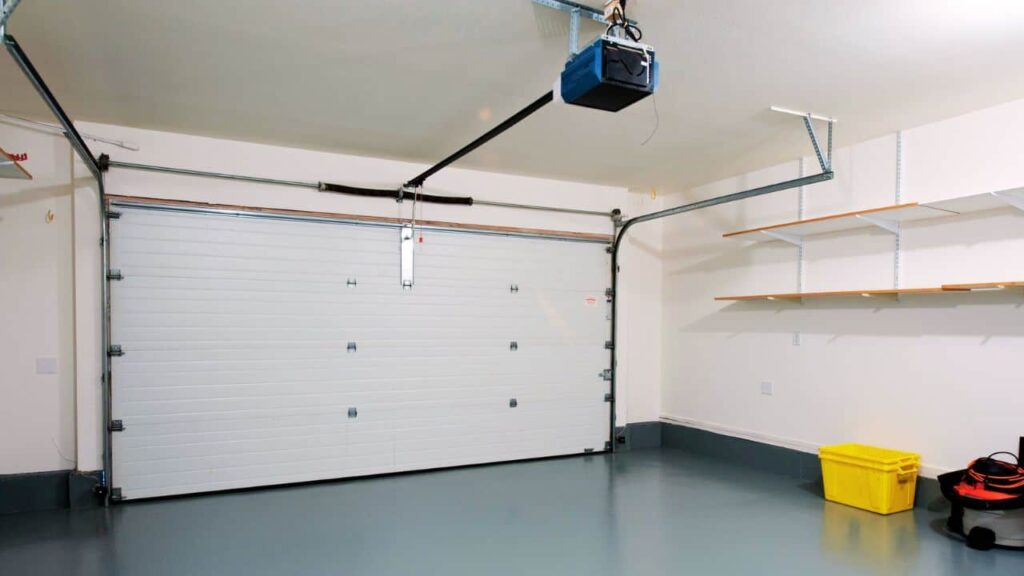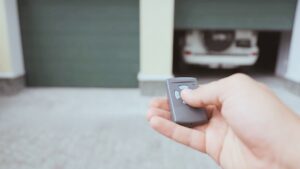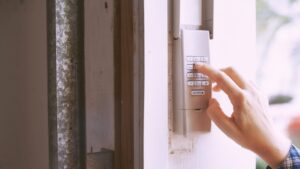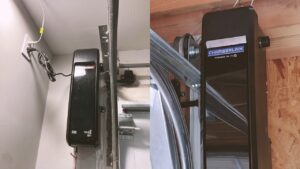Is your garage door not working properly, and you can’t figure out what’s wrong?
Knowing about the different garage doors parts names should help.
A garage door system seems complex at first, but once you get the hang of its different parts and roles, diagnosing the problem becomes much easier.
In this article, we’ll look at all the main parts of a garage door and how they work. We’ll also talk about some of the most common garage door problems and what might be causing them.
So, let’s get to it.
Garage Door Parts Diagram
Here is a diagram that provide you visual representation of all essential components that make up a garage door system:
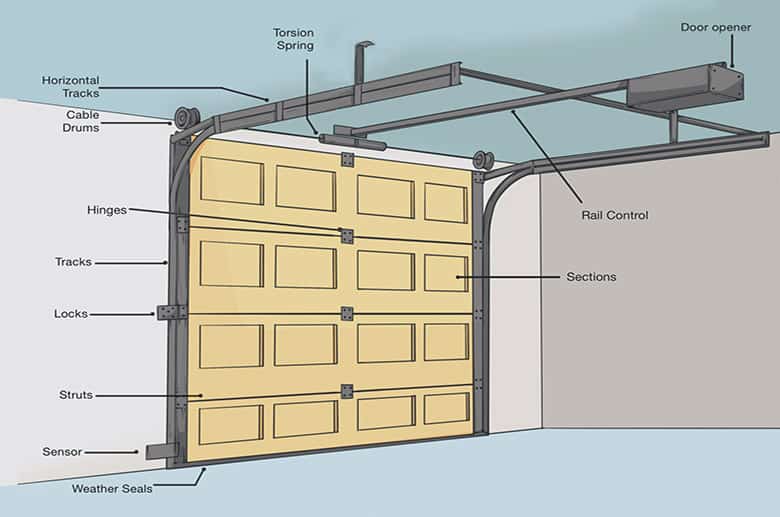
Components of a Garage Door
A garage door is a collection of various electrical and mechanical components that work together to protect your car and other valuable items. As a homeowner, you should know about these different parts to help diagnose and troubleshoot problems with your garage door.
Hardware Garage Doors Parts Names
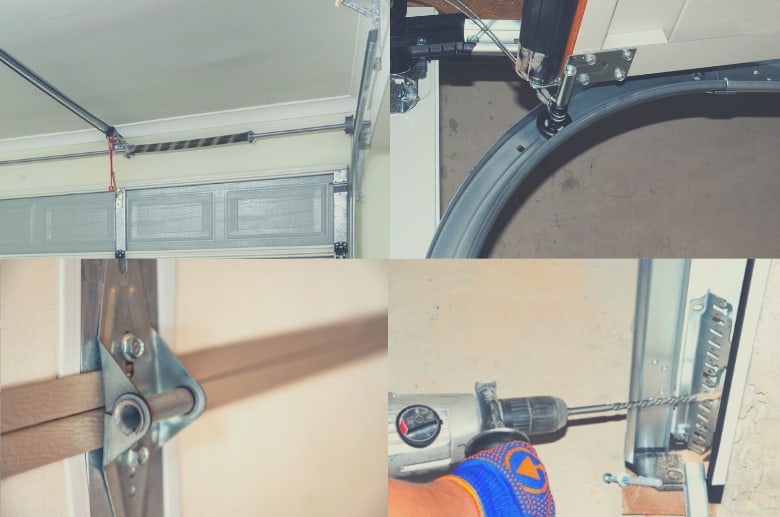
Here’s a list of the main hardware components that allow your garage door to work:
Springs
Garage doors use springs (torsion or extension springs) that retain potential energy. This energy balances out the door’s weight, so when you’re lifting your garage door, you’re not the only one doing all the hard work.
Even with automatic garage doors, the motors don’t do all the heavy lifting. The garage door springs lift the door while the motor controls its movement. So the use of springs makes the garage door mechanism energy efficient.
Tubes, Drums, and Cables
A cylindrical tube shaft is fixed above the garage door, keeping the torsion springs in place. It also protects the garage door frame from damage if the garage door hits it during operation.
At each end of the tube shaft is a pulley wheel called a garage door drum that rotates when the springs unwind.
Garage door cables are flexible metal lifting wires that connect the garage door drums to the door. As the drum rotates, it rolls up the cables, pulling up the garage door.
Rollers & Tracks
On each side of the garage door track (horizontal or vertical), that guide the garage door operation and rollers that fit inside the track.
The rollers help slide the garage door on the tracks as it opens and shuts. If for some reason, the garage door goes off track, it won’t open.
Brackets
Brackets connect and support the garage door mechanism. Garage doors have lag and jamb brackets that fasten the cables and rollers to the garage door.
Panels & Hinges
Most garage doors are made up of multiple rectangular panels or sections. These panels come in various designs (long, short, and flush), materials (wood, vinyl, fiberglass, steel, aluminum, etc.), and colors.
These garage door panels have hinges between them. The hinges connect the panels and allow them to fold smoothly together to allow the garage door to open.
Locks and Handles
Like all doors, garage doors come with a variety of handle and lock systems for added security. Some of the most common are:
- Deadbolt lock
- T-handle lock
- Digital keyless lock
- Garage door defender
- Magnetic locks
- Automatic garage door locks (electric)
Connect With A Garage Expert
Connect with local experts, Compare quotes, Get the best price.
Weather Seal
Your garage door is the only thing between your garage and the outside elements. Sadly, your garage door can’t protect the valuables inside your garage from harmful environmental elements, and that is because there’s a small gap between your garage door and the walls.
Weather seals or weatherstripping seal this gap and help maintain the temperature inside your garage. Weather seals protect the valuables inside your garage door from rust, debris, and moisture and help save energy.
Unlike other garage door components, damage to weather seals is not obvious, so you should habitually inspect your garage door weather seal a few times a year. If damaged, repair or replace it.
Electrical Components
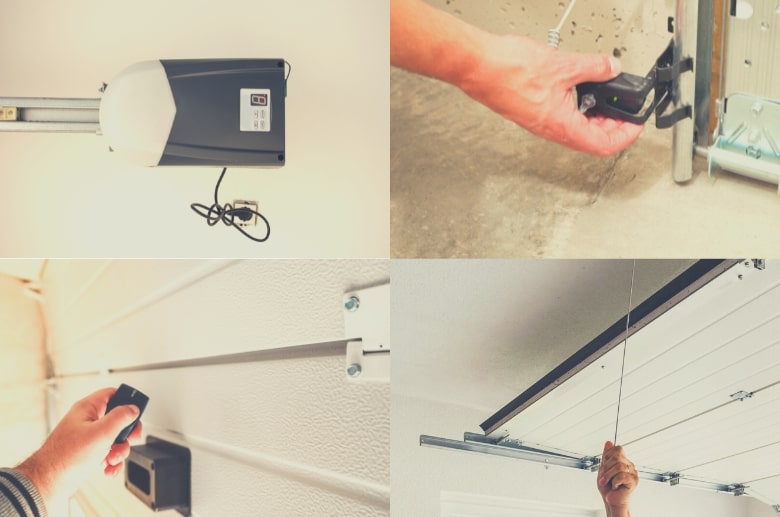
Here’s a list of the main hardware components that allow your garage door to work:
Garage Door Opener
The most essential component of a garage door is its opener. It’s a box-shaped device that hangs from the ceiling and comes with extension cords that you plug into an electrical outlet. The garage door opener consists of the following:
- Motor
- logic board
- Gears
- Sensors
- Inverter
- backup battery (to use in case of a power outage)
There are three main types of garage door openers:
- Electric (which uses electricity)
- Hydraulic (which uses pressurized oil)
- Pneumatic (which uses pressurized air)
Electric openers are the most common and found in most residential garage doors.
Drive Mechanism
Garage door openers use a drive mechanism to lift and lower your garage door.
Trolley-driven garage door openers come with the following types of drive mechanisms:
- Chain drive openers are cost-effective but make a lot of noise.
- Screw drive openers don’t require much maintenance, but they’re also noisy.
- Belt drive openers are gaining popularity because they are quite durable and operate smoothly without making a lot of noise. They are the most expensive.
Remote Control Systems
Homeowners can use a button, keypad, or remote controller to signal the sensors to open or shut automatically. Some modern garage doors also offer Wi-Fi-enabled garage door openers that you can operate using a smartphone app.
Photo Eye Beam Sensors
Since garage doors are quite heavy, they pose a safety hazard. Even a little bit of carelessness can result in car damage or serious injury. To prevent such accidents, garage doors come with photoelectric beam sensors.
If something is under the garage door, the beam of light is broken, preventing the door from shutting.
Emergency Cord
The garage door opener also has a pull string or emergency cord that lets you manually operate your garage door in case the motor or remote doesn’t work.
Inspections and Maintenance
Regular garage door maintenance and inspection are essential if you want your garage door to work optimally for a longer lifespan. It also helps detect issues beforehand, preventing them from causing major problems that cost a lot to repair. More importantly, a malfunctioning garage door can be a major safety hazard, and regular garage door maintenance prevents such issues.
Here’s a garage door inspection and maintenance checklist for your reference:
| Garage Door Inspection & Maintenance Checklist |
| 🮱 Visual Inspection | 🮱 Check for loose nuts and bolts | 🮱 Check for damaged hinges | 🮱 Inspect the rollers |
| 🮱 Test if it opens and shuts properly | 🮱 Add lubrication | 🮱 Check for rust and bends in the vertical and horizontal tracks | 🮱 Check cables and pulleys for signs of damage |
| 🮱 Inspect center bearing | 🮱 Check for bends or damage on the center bracket | 🮱 Check if the jam brackets are in the correct position | 🮱 Check for broken springs |
| 🮱 Test the garage door balance | 🮱 Check for mold | 🮱 Check garage door insulation | 🮱 Check for bearing plate damage |
| 🮱 Check for weather seal wear and tear | 🮱 Clear debris from the tracks | 🮱 Test the backup battery | 🮱 Check for bending in the spring bar |
| 🮱 Test the photo eye safety sensors | 🮱 Check remote control batteries | 🮱 Check the wires | 🮱 Inspect motor gears |
You should get an annual garage door inspection by a professional at least once. However, the Consumer Product Safety Commission (CPSC) also recommends that you check your garage door and garage door opener every month or so.
Potential Problems With Garage Door Parts
Garage doors are complex systems that often malfunction. Below are a few common garage door issues and tips on how to fix them:
1. Automatic Garage Door Doesn’t Close
The misalignment of safety sensors usually causes this problem.
Two safety sensors are attached to the two side walls at the bottom of the garage opening. The placement of the sensors is such that they face each other. One of the sensors projects a beam of light into the lens of the other. If the sensors are not properly aligned, the beam will not reach the receiving sensor preventing the garage door from closing.
See if your safety sensors are adjusted properly. If not, adjust them, so they face each other. By doing this, your garage door should close.
2. Garage Door Opens Up With Difficulty
If you need to apply more force to open up your garage door or if it’s making weird sounds, you might have a lubrication problem on your hands. In such cases, check the lubrication on the screw drive operator rails and garage door hinges. If it’s not lubricated, add lubrication, and your garage door should stop making weird sounds and open with ease.
Note: Chain and belt drives do not need lubrication.
3. Garage Door Motor Lost Power
Over time, your garage door motor will lose power and strength. To fix this, find the motor limit switches on the side of your motor and adjust them.
Connect With A Garage Expert
Connect with local experts, Compare quotes, Get the best price.
When to Call an Expert for Repairs or Service
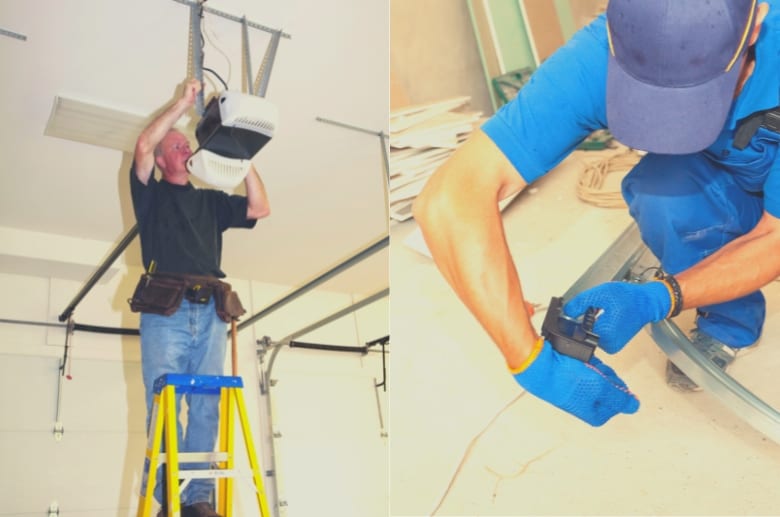
Some garage door issues have easy fixes, such as realigning the garage door sensors. But, the issues are often hard to fix for the average homeowner. But when should you call a professional? Ask yourself:
- Is your garage door making unusual noises, such as scraping or grinding?
- When you try to open your garage door, does it close immediately?
- Does it open up immediately when you try to close your garage door?
- Is your garage door stuck?
- Did your garage door rollers, belts, or chains wear out?
- Do you notice any cracks in your garage door?
- Did you hear a loud bang when operating your garage door?
- Has it become unusually hard to open or close your garage door?
- Is there rust on your garage door springs?
You need to call a professional garage door service if your answer is “yes” to more than a few of the questions mentioned above.
Final Thoughts
A garage door’s various mechanical and electrical components work harmoniously to operate the system. Some parts allow the garage door to operate smoothly, e.g., garage door opener, springs, rollers, and tracks. Others offer safety, such as garage door handle locks and photoelectric eye beam sensors.
Garage doors also require regular maintenance and inspections to operate safely and efficiently. You can do regular checkups and clean your garage door yourself. But you’ll need to hire a professional garage door service to thoroughly inspect and repair your garage door at least once per year.
Frequently Asked Questions
Still have questions about the components of a garage door? Here are answers to some of the most common questions about garage door parts:
What is the most common problem with garage doors?
One of the most common garage door issues homeowners face is a garage door stuck in the open position. While this can occur for a variety of reasons, it’s often because the photo-eye sensors are blocked or not well-adjusted.
By adjusting the photo-eye sensors to face each other, you can often resolve the problem.
What is the bottom part of a garage door called?
Most garage doors have a rubber seal at the bottom to prevent drafts from getting inside your garage. This rubber seal is called an astragal.
What is a strut on a garage door?
Long steel bars, called garage door struts, are screwed horizontally into the garage door interior. Garage door struts reinforce the garage door panels, stiffen them, and allow the door to open and shut smoothly.
Without garage door struts, the garage door can bend or break under its weight.

